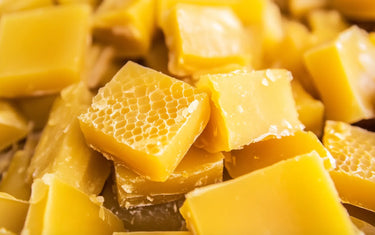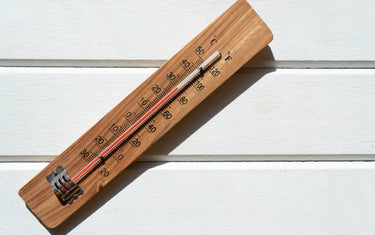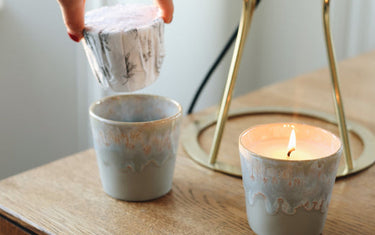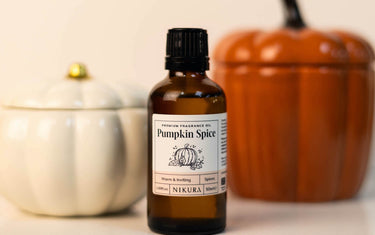7 min read / 31 August 2025 / yasmin sharp
The Benefits of Beeswax in Skincare Products
Discover the centuries-old skincare secret of beeswax and learn how this natural ingredient provides antimicrobial protection, moisture retention, and healing properties for healthier, more radiant skin.
Share this post

The benefits of beeswax for skin have been realised for hundreds of years, with people from all over the world using it for their cosmetic applications.
The Egyptians added it into their hair preparation cosmetics to hold curls and braids in place, while Chinese people mixed it with musk to make a fragrant anti-inflammatory lotion.
Some of the largest brands in the world include it in their products today, using beeswax for hand creams, balms, ointments, salves and medical treatments.
We take a closer look at its relationship with cosmetics to find out more about the many beeswax healing properties you could enjoy.

How is beeswax used for skincare products?
Beeswax is commonly used as a thickener in occlusives, which are products that form a barrier on top of your skin to reduce moisture evaporation. It can also act as an emulsifier if combined with an ingredient such as borax. When companies use beeswax for cosmetics it will either be listed as cera flava (yellow wax) or cera alba (white wax).
Before it can be used as a cosmetic ingredient, the beeswax is removed from honeycombs and melted, before solar, electric, or steam-based extraction methods are used to separate any impurities. Once it has been processed, beeswax is used as the base for emollient skin creams, lotions, ointments and lipsticks.
The physical properties of cosmetic products can be altered by the addition of beeswax, such as enhancing the colour of a lipstick and increasing its hardness and lustre. For example, when used as a stiffener, beeswax can enhance plasticity, elasticity and boost skin adhesiveness. Studies have found beeswax to be non-irritating to skin, while also producing a low comedogenic rating, as it is less likely to clog skin pores. [1]
Benefits of beeswax for the skin
Boost antimicrobial protection
The hydrophobic properties (which means it is able to repel water) contained in beeswax make it ideal for use in cosmetic and body products.
Researchers looking into the microbial benefits of beeswax found that it demonstrated some ability to restrict the growth of S. aureus and C. albicans, which can be responsible for the growth of various bacteria on the skin. [2]
The effects were found to be even greater when beeswax is combined with honey and olive oil, which in some cases was able to completely inhibit growth.
Protect the skin barrier
Our skin is constantly at work, helping to protect us from all manner of environmental irritants, including bacterial infections and radiation emitted from the sun.
Beeswax is great at locking in moisture and can be used as an effective alternative to petroleum-based products, which is ideal for anyone who doesn't enjoy the greasy texture on their skin.
One study examined how two commercial skin barrier creams compared to a moisturiser containing beeswax. [3]
They found that the beeswax-based moisturiser not only helped to retain more moisture in the skin, but also improved the condition of the skin, reducing the appearance of scaling, fissures and redness.
Help to combat dermatitis and psoriasis
Although human studies have yet to be conducted, researchers have noted some positive results from the use of cera flava, a natural extract from beehives that is commonly used in cosmetic products.
When house dust was used as a skin irritant in a dermatitis mouse study, researchers learned that the extract increased skin moisture and helped to restore certain skin barrier proteins. [4]
A human study has been carried out to test the effectiveness of using a mixture of olive oil, honey and beeswax. [5]
Results found that 8 out of the 10 patients who used the mixture to treat dermatitis saw a significant improvement after two weeks, while 5 of the 8 patients who used the mixture to treat the psoriasis showed a significant response.
Treat and soothe burns
While studies are needed to assess the effects of using beeswax alone for treating burns, studies have been carried out using olive oil, honey and beeswax.
One focussed on the treatment of second-degree burns in canines, finding that wound contraction was greater in the animals that were treated with the mixture. [6]
They also noted that there was less release of fluid and inflammatory reaction following application.
In another study, this time looking at the treatment of second-degree burns in rats, researchers used a combination of calcium hydroxide powder, beeswax and sesame oil. [7]
In comparison to another group that were treated with normal saline, they found that after 10 days the mixture helped to increase the wound closure rate and the growth of new blood vessels, while collagen formation occurred after 2-3 weeks.

Beeswax allergies and precautions
While there are plenty of beeswax skin benefits, it’s important to safeguard your skin before application.
You can do this by completing a simple patch test, which involves placing a small amount of beeswax on your inner elbow. Cover with a plaster for 24 hours and keep an eye out for any redness, inflammation or itchiness.
If you see any of these reactions, wash the beeswax off your skin right away and do not use any more beeswax products.
It’s also recommended that you repeat this process for any essential oils you intend to use for the first time.
Beeswax skincare recipes
Beeswax uses for skin can serve to boost moisture retention and improve hydration, helping skin to feel more beautiful and supple.
We’ve put together a few simple recipes to make it easier for you to introduce one of nature’s wonders into your daily skincare routine.
Beeswax lip balm recipe
Adding beeswax into a lip balm recipe can help to seal in moisture and protect against dryness – which can do wonders for your lips during the autumn and winter. To get started you will need:
- 26g beeswax
- 26g coconut oil
- 26g sunflower or almond oil
- 16 drops peppermint essential oil
- 8g lanolin
- 2 drops rosemary extract
- 1g vitamin E
- 1g castor oil
Method
- Use a double boiler to melt the beeswax on a low heat, ensuring to slowly stir as you go.
- Add all the oils except the vitamin E and essential oil) and blend into the mixture.
- Remove the wax from the cooker and let it cool to 76°C or cooler.
- Add the essential oils and vitamin E and stir to combine.
- Pour the mixture into your containers and leave to cool and set overnight.
Beeswax hand lotion recipe
Using beeswax for hand cream allows you to enjoy similar benefits for your hands, which can keep your skin feeling soft and supple after application. The method is similar to the lip balm but with a few key differences in the ingredients:
- 56g shea butter
- 56g coconut oil
- 56g almond oil
- 28g beeswax
- 1 teaspoon vitamin E oil
- Few drops of essential oil of choice – rose, chamomile and lavender work well
Method
- Melt the beeswax, coconut oil, shea butter and almond oil in a double boiler, slowly stirring until fully melted.
- Remove the mixture from the cooker and leave it to cool for 5 minutes.
- Add your essential oils and vitamin E oil and blend into the mixture.
- Pour the beeswax lotion into your container and leave it to cool and solidify.
Beeswax salve recipe
Every good first aid kit needs a salve of some kind, and this one allows you to include some beeswax skin benefits in the recipe. For this you’ll need:
- ½ cup high coconut oil
- ½ cup pure beeswax pellets
- 1 tablespoon witch hazel
- 10 drops lavender essential oil
- 10 drops lemon essential oil
- 5 drops frankincense essential oil
- Small mason jars (or lidded containers of choice)
Method
- Use a double boiler to mix the beeswax pellets with the coconut oil – stir slowly until fully melted.
- Take off the heat and allow the mixture to cool for 5 minutes.
- Add the essential oils and witch hazel, mix until all ingredients are completely melted.
- Carefully pour the mixture into the containers and leave to cool. You can seal with lids once the mixture has fully set.

Final thoughts
Once you learn more about the benefits of beeswax for skin, you’ll have a whole host of new treatment options for your skincare routine.
It offers anti-inflammatory and antimicrobial properties, whilst creating a protective barrier on your skin that helps to lock in moisture and combat the signs of ageing.
If you are using beeswax or a beeswax-based product for the first time, be sure to carry out a patch test to safeguard against allergies, and also do the same if you are including essential oils in your recipe.
[1] Peter A Lewis et al. (2012) A randomized controlled pilot study comparing aqueous cream with a beeswax and herbal oil cream in the provision of relief from postburn pruritus https://pubmed.ncbi.nlm.nih.gov/22665131/
[2] Filippo Fratini et al. (2016) Beeswax: A minireview of its antimicrobial activity and its application in medicine https://www.sciencedirect.com/science/article/pii/S1995764516301407?via%3Dihub
[3] Anna Kurek-Górecka et al. (2020) Bee Products in Dermatology and Skin Care https://pubmed.ncbi.nlm.nih.gov/32012913/
[4] Peter J Frosc et al. (2003) Efficacy of barrier creams in comparison to skin care products in dental laboratory technicians--a controlled trial https://pubmed.ncbi.nlm.nih.gov/16295040/
[5] Noori S Al-Waili (2003) Topical application of natural honey, beeswax and olive oil mixture for atopic dermatitis or psoriasis: partially controlled, single-blinded study https://pubmed.ncbi.nlm.nih.gov/15022655/
[6] Alaa Moustafa et al. (2015) The Effectiveness of a Mixture of Honey, Beeswax and Olive Oil in Treatment of Canine Deep Second-Degree Burn https://www.academia.edu/download/37584079/13_1.pdf
[7] Yvonne Nong MS et al. (2023) A review of the use of beeswax in skincare https://onlinelibrary.wiley.com/doi/10.1111/jocd.15718










